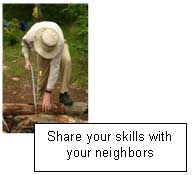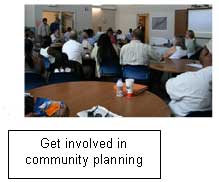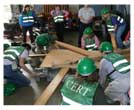Why This is Important
Pandemic flu will be personal. It will affect our communities, our neighborhoods, and ourselves. We believe the best answer to the potential devastation of a pandemic is individual/household preparation plus community sustainability.
There is no one right way to get involved: people have different skills, interests and abilities. Following are some suggestions.
Start at Home
A resilient community is based onsecure individuals and families. 1. Get your house in order. Have at least three months of food, water (or purification capability), medications and basic supplies.
 2. Build relationships with your neighbors.
2. Build relationships with your neighbors. Know your neighbors. Share dinner, have block parties. Learn whom you can trust and who you can't. Establish or join “neighbor to neighbor” emergency programs, such as Neighborhood Watch. Contact your local law enforcement for more information.
3. Build your personal skill set. As you work towards increased resilience, you will learn new skills. Ask neighbors who are knowledgeable in different areas to teach those to you. Reciprocate with a favor to them, of course. This helps you help them and builds trust and connections in your neighborhood.
Expand to Your Community
A resilient community plans together. 1. Get involved in pandemic planning. Our critical infrastructure is at risk. Backup systems need to be identified and checked out. Ask your local government officials how their plans address the following:

- overwhelmed healthcare system
- uncertain supply of chemicals for good drinking water
- interruptions to food supply
- degraded/failed electricity
- identifying households in need during a pandemic
2. Expand community skill set Use your skills to strengthen your community. An example could be starting a community garden.
Example Programs to Build Community Sustainability
Official programs are directed from the top down and have their place. However, for community resilience, we also need grassroots groups of informed neighbors. Even socializing with people on your street and in your immediate area may bring lasting benefits and build ties that you will count on in an emergency. While few people take the time to know their neighbors, by working on tasks together, planning activities and socializing, you can build relationships that will help you and your neighbors fare better in a disaster.
How can this connection be built? It can't be forced, but it can be encouraged.

- have block parties and pot luck suppers with your neighbors
- learn who can share tools and childcare
- gather together with neighbors to create welcome baskets and/or meals to new families
- establish community gardens
- share work days (I help you build your wall, you help me chop a tree up)
The importance of this type of social interaction cannot be overstated. All were part of civic life a generation or so ago and can be encouraged again.
In addition, there are official groups which help communities in a disaster. Many of these organizations are recruiting volunteers, and adding to their number benefits the community.

IMPORTANT!! If you volunteer for any program with a community role in pandemic flu response, you MUST ensure that you have personal protective equipment. If you do not have it, or it is not provided to your standards, then you should not participate.
This is a tough reality when there is overwhelming need. BUT…if you become sick, you are now part of the problem, not part of the solution. TAKE CARE OF YOURSELF FIRST
Example Organizations
 1. Community Emergency Response Team (CERT)
1. Community Emergency Response Team (CERT). This program educates people about disaster preparedness and trains them in basic disaster response skills such as fire safety, light search and rescue, and disaster medical operations. Using their training, CERT members can assist others in their neighborhood or workplace following an event and can take a more active role in preparing their community.
2. Medical Reserve Corps (MRC). This program strengthens communities by helping medical, public health and other volunteers offer their expertise throughout the year, as well as during local emergencies and other times of community need. MRC volunteers work in coordination with existing local emergency response programs. They also supplement existing community public health initiatives, such as outreach and prevention, immunization programs, blood drives, case management, care planning, and other efforts.
3. American Red Cross (ARC). The American Red Cross provides relief to victims of disasters and helps people prevent, prepare for, and respond to emergencies. They also provide a variety of health and safety education and services.
 4. The Salvation Army
4. The Salvation Army. The Salvation Army has a variety of programs such as disaster relief services, day care centers, summer camps, holiday assistance, services for the aging, AIDS education and residential services, medical facilities, shelters for battered women and children, family and career counseling, vocational training, correction services, and substance abuse rehabilitation.
 5. Amateur radio
5. Amateur radio The Amateur Radio Emergency Service (ARES) was started by the
American Radio Relay League (ARRL) and consists of licensed amateurs who have voluntarily registered their qualifications and equipment for communications duty in the public service when disaster strikes. The ARRL also has several emergency communications courses available on line.